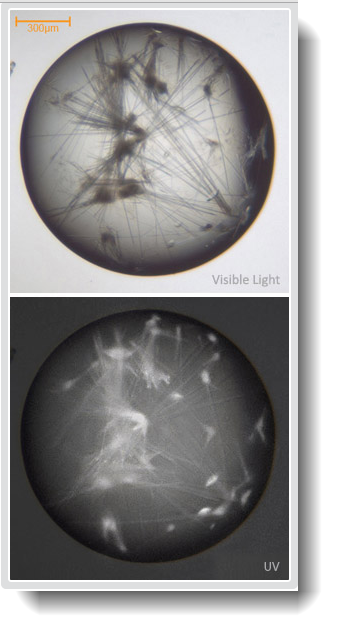UV Imaging (Optional)
FORMULATRIX's ultraviolet (UV) imaging technology uses the fluorescence of tryptophan under UV light help you distinguish between protein and salt crystals and reveal crystals that may not be located with visible light. Our UV solution uses 100% UV-optimized components, including UV-grade optics, a UV-sensitive camera, and UV lighting.
ROCK IMAGER UV can be purchased as a retrofit for an existing ROCK IMAGER® or as an option on a new ROCK IMAGER®.
Optimized UV Epi-Illumination
The UV LED and condenser lens is positioned to maximize the intensity of the UV illumination to 35.7 uW/mm2 in order to boost the protein fluorescence signal strength.
Zoom Options
ROCK IMAGER UV comes in two zoom options: Fixed Zoom and Compound Zoom. The Fixed Zoom option is available with either a 2.5x, 5.0x or 7.0x objective. The Compound Zoom option includes all three lenses on a motorized wheel.
Single Light Path vs. Dual Light Path
UV imaging is available as a single optical pathway can be used for both visible and UV imaging. Advanced UV imaging leverages separate, optimized optical paths for visible and UV imaging. The visible optical pathway is independent from UV imaging so there is no compromise in image quality or features. For specific information about each of the light paths and objectives, refer to the tables below.
Single Light Path Visible and UV Optical Specifications
Objective | Effective NA | Depth of Field (mm) | Field of View (mm) | Working Distance (mm) |
1.5x (Visible only) | 0.06 | 4.5 | 3.6 x 2.7 | 5.0 |
2.9x (Visible and UV) | 0.30 | 2.4 | 1.8 x 1.3 | 2.7 |
9.5x (Visible and UV) | 0.32 | 0.7 | 1.3 x 1.0 | 8.5 |
Dual Light Path UV Optical Specifications
Objective | Effective NA | Depth of Field (mm) | Field of View (mm) | Working Distance (mm) |
2.5x | 0.42 | 0.15 | 3.6 x 2.7 | 2.58 |
5.0x | 0.32 | 0.07 | 1.8 x 1.3 | 1.29 |
7.0x | 0.40 | 0.02 | 1.3 x 1.0 | 0.93 |
Note: Click here to download the UV Imaging Guide.
FORMULATRIX® is proudly powered by WordPress
